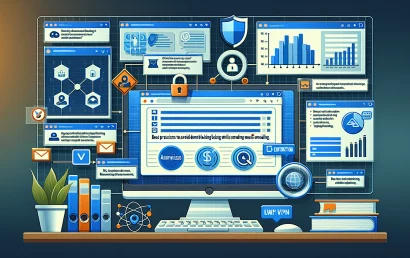Domain Warming Tools

In the world of email marketing, domain warming is a crucial process that helps improve the deliverability of your campaigns. As businesses increasingly rely on email to connect with their audience, understanding the tools available for domain warming becomes essential. These tools not only facilitate the gradual increase of your sending volume but also help establish a positive sender reputation.
Domain warming involves gradually ramping up the number of emails sent from a new domain to build trust with Internet Service Providers (ISPs). Without proper warming, your emails may end up in spam folders or be blocked entirely. In this article, we will explore various tools that can assist in effectively warming your domain, ensuring that your email campaigns reach their intended recipients.
Essential Tools for Domain Warming
Email Service Providers (ESPs)
One of the most crucial tools for domain warming is a reliable Email Service Provider (ESP). ESPs offer features that allow you to manage your email campaigns efficiently while also providing insights into your sender reputation. Many ESPs have built-in tools that help automate the warming process by gradually increasing your sending limits.
“Choosing the right ESP can significantly impact your domain warming strategy and overall email deliverability.”
Warmup Services
Dedicated warmup services are specifically designed to help you warm up your domain. These services typically send a series of emails from your new domain to real inboxes, gradually increasing the volume over time. They monitor engagement and adjust sending patterns based on performance metrics, ensuring that your domain is recognized as a legitimate sender.
Monitoring Tools
Effective domain warming requires continuous monitoring of your email performance. Monitoring tools can provide valuable insights into your open rates, click rates, and bounce rates. By keeping an eye on these metrics, you can make informed decisions about your warming strategy and quickly address any issues that may arise.
Feedback Loops
Utilizing feedback loops from ISPs can also be a vital part of your domain warming process. Feedback loops allow you to receive reports on how recipients interact with your emails, including complaints and spam reports. This information is crucial for adjusting your strategy and maintaining a positive sender reputation.
In summary, leveraging the right tools for domain warming can significantly enhance your email marketing efforts. By using ESPs, warmup services, monitoring tools, and feedback loops, you can create a robust warming strategy that ensures your emails reach your audience effectively.
Main advantages and disadvantages
Advantages of Domain Warming Tools
Utilizing domain warming tools comes with several benefits that can enhance your email marketing effectiveness:
- Improved Deliverability: By gradually increasing your sending volume, these tools help establish your domain's reputation, resulting in higher deliverability rates.
- Enhanced Sender Reputation: Consistent engagement and low complaint rates contribute to a positive sender reputation, making it less likely for your emails to be marked as spam.
- Automated Processes: Many tools offer automation features that simplify the warming process, saving you time and effort while ensuring consistent sending patterns.
- Real-Time Monitoring: With monitoring tools, you can track performance metrics in real time, allowing for quick adjustments to your strategy based on engagement levels.
- Data-Driven Insights: Feedback loops and performance analytics provide valuable insights into how your emails are received, enabling you to refine your approach continuously.
Disadvantages of Domain Warming Tools
While there are many advantages, there are also some potential drawbacks to consider:
- Cost: Some warming tools and services can be expensive, especially for small businesses or startups with limited budgets.
- Complexity: Navigating multiple tools and platforms can be overwhelming, particularly for those new to email marketing.
- Time-Consuming: The warming process can take time, and results may not be immediate, requiring patience and consistent effort.
- Dependency on Tools: Relying too heavily on automated tools may lead to complacency in monitoring and optimizing your email strategies manually.
- Risk of Mismanagement: If not used correctly, warming tools can lead to poor sending practices, which may harm your sender reputation instead of helping it.
Thematic table
| Tool Name | Type | Key Features | Advantages | Disadvantages | Best For |
|---|---|---|---|---|---|
| Mailgun | Email Service Provider | API access, analytics, automated warmup | Scalable, reliable, robust analytics | Can be complex for beginners | Businesses looking for a powerful ESP |
| Warmup Inbox | Warmup Service | Automated warmup, engagement tracking | Easy to use, fast results | Monthly fees can add up | New domains needing quick warmup |
| SenderScore | Monitoring Tool | Sender reputation score, insights | Free to use, easy to understand | Limited features compared to paid tools | Small businesses checking reputation |
| Gmail Postmaster Tools | Monitoring Tool | Domain reputation, spam rate monitoring | Direct insights from Google, free | Limited to Gmail users | Businesses targeting Gmail users |
| Mailchimp | Email Service Provider | Email automation, analytics, segmentation | User-friendly interface, strong support | Can be pricey for larger lists | Small to medium-sized businesses |
| Postmark | Email Service Provider | Transactional email focus, analytics | High deliverability, fast delivery | Not ideal for marketing emails | Businesses focused on transactional emails |
| SendGrid | Email Service Provider | API, analytics, email testing | Scalable, robust features | Can be complex for new users | Developers and businesses needing APIs |
| Mail Tester | Monitoring Tool | Email testing, spam score analysis | Free to use, easy to analyze | Limited features compared to comprehensive tools | Individuals and small businesses testing emails |
Let's summarize the category:
In summary, the tools available for domain warming play a vital role in enhancing the effectiveness of email marketing campaigns. By utilizing these tools, businesses can ensure that their emails reach the intended recipients and maintain a positive sender reputation.
Choosing the right tool depends on various factors, including the size of your business, your budget, and your specific email marketing needs. Whether you opt for an Email Service Provider, a dedicated warmup service, or monitoring tools, each option offers unique features that can contribute to a successful warming strategy.
“The key to successful email marketing lies not only in crafting compelling messages but also in ensuring that those messages reach the inbox.”
As you explore the various tools for domain warming, consider the advantages and disadvantages of each. This thoughtful approach will help you implement a warming strategy that maximizes deliverability while minimizing potential pitfalls. With the right tools and a well-planned strategy, you can effectively warm your domain and elevate your email marketing efforts to new heights.





